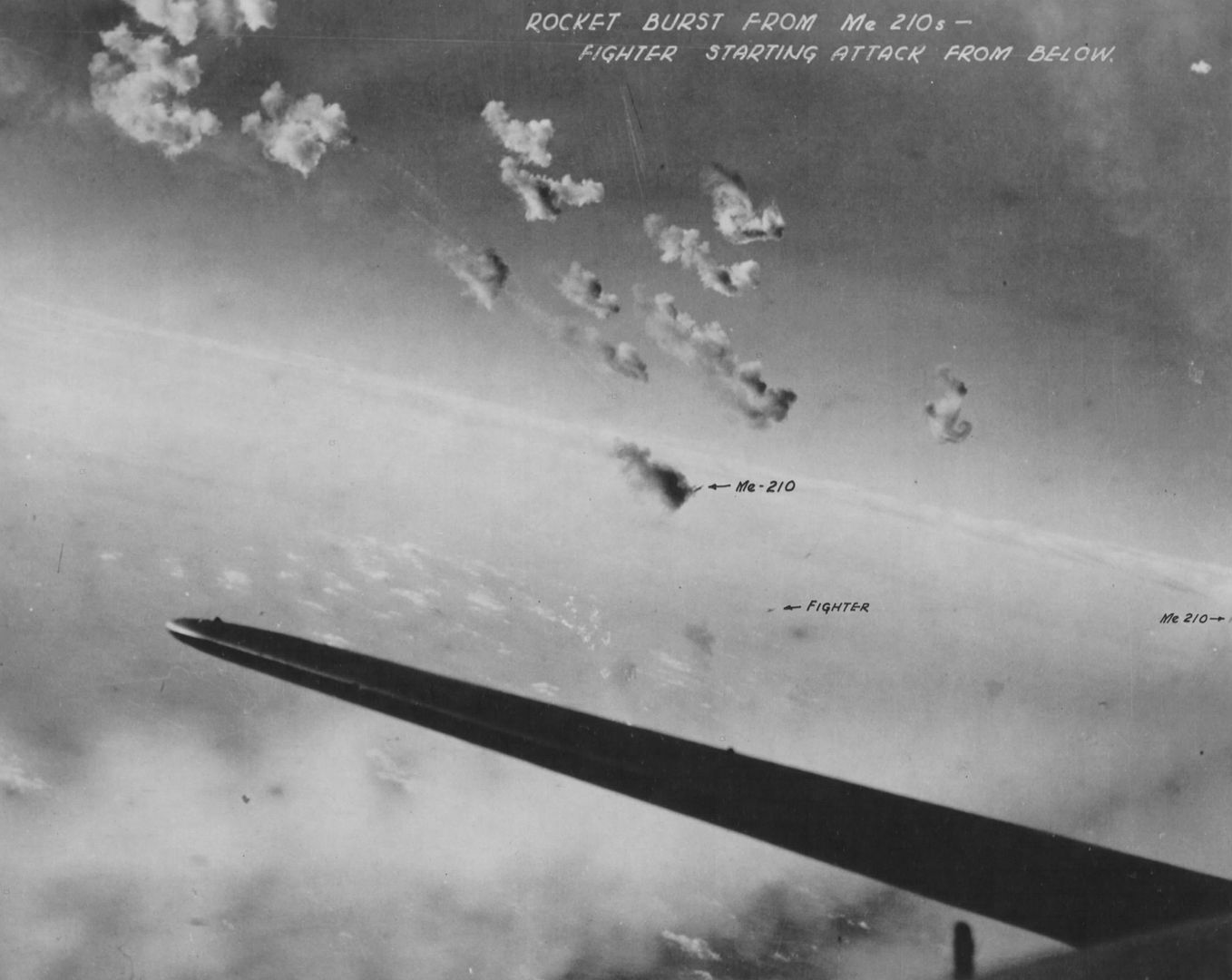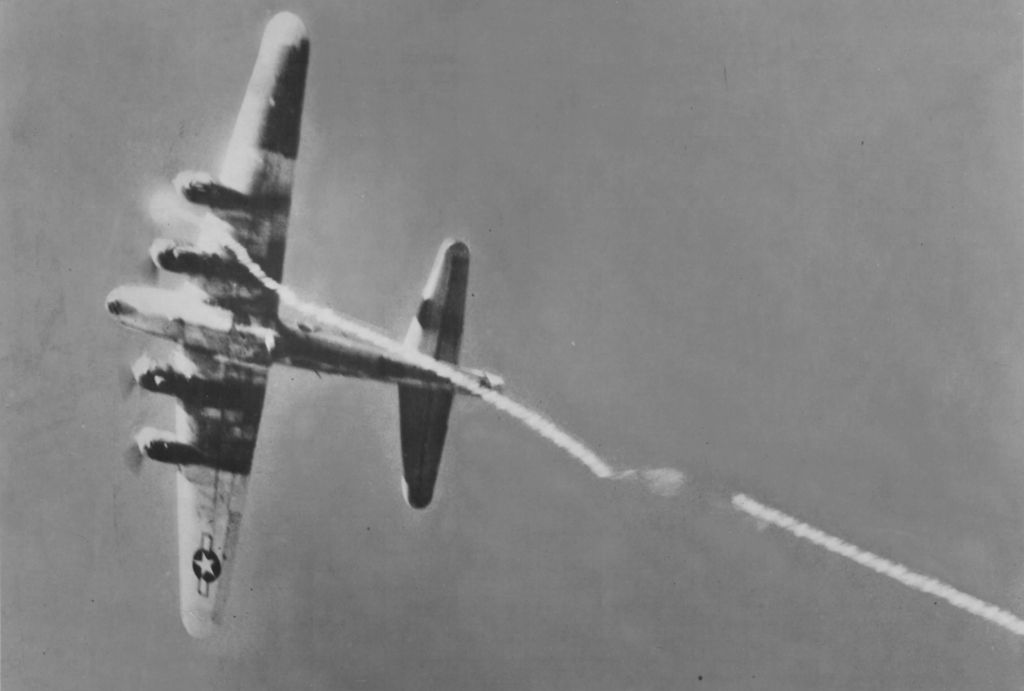Read the forum code of contact
By: - 5th July 2018 at 00:08 Permalink - Edited 1st January 1970 at 01:00
Someone on Facebook has suggested it may have been these. Did the night fighters use these weapons in March 1944?
By: - 5th July 2018 at 00:46 Permalink - Edited 1st January 1970 at 01:00
Im thinking these maybe?
https://www.youtube.com/watch?v=elqD2m1q78c
By: - 5th July 2018 at 05:02 Permalink - Edited 1st January 1970 at 01:00
There were some articles about German special air-to-air weapons in The Aviation Historian, I'll have a look tonight.
By: - 5th July 2018 at 05:37 Permalink - Edited 1st January 1970 at 01:00
Possibly Fw190 Nightfighters as they usually carried the WG21,s.
By: - 5th July 2018 at 06:37 Permalink - Edited 1st January 1970 at 01:00
Thanks.
By: - 5th July 2018 at 10:59 Permalink - Edited 1st January 1970 at 01:00
The article in TAH17 is mainly about the trials unit rather than operational use. The examples of WG.21 use given are about attacks on daylight formations, to break them up. However it isn't designed to be a comprehensive review of the weapon in action.
By: - 5th July 2018 at 11:35 Permalink - Edited 1st January 1970 at 01:00
Didn't some of the Me110G-4 nightfighter units use the 4 x WG-21 fit at various times, have a vague recollection that Schnaufer used a 4 x WG-21 equipped G-4 operationally for a while....?
By: - 5th July 2018 at 20:49 Permalink - Edited 1st January 1970 at 01:00
I heard a Bomber Command veteran’s account of watching the Jerries launching rockets at daytime bomber raids from the ground. They saw this from inside their POW camp. Wonder what they were?
By: - 5th July 2018 at 22:58 Permalink - Edited 1st January 1970 at 01:00
The language used is interesting: 'attacked' is generally the term used to describe being engaged by a fighter. The 'flak' terminology is generally less personal (and more derogatory) as flak crews were not 'aircrew'. Also 'rocket projectile', rather than just 'rocket' makes me think that these were rockets fired by a fighter (and 'rocket projectile' was the common terminology used to describe RAF fighter-bomber rockets). Not conclusive, obviously.
My guess would be, as has already been suggested, that these were WG21 rockets fired by a 'Wild Boar' single-engined 'nigh-fighter'.
By: - 5th July 2018 at 22:59 Permalink - Edited 1st January 1970 at 01:00
Here's famous photo of a 262 R4M kill.
Quote -- "Taken by Harold Dorfman USAF "This ship (Red Bow) was a Ford-built B-24M, serial number 44-50838. She was shot down by a German Messerschmitt ME 262 on April 4th, 1945 by an R4M air-to-air missile. Ed Chu was a tail gunner in the 448th and saw the plane go down and thought for sure no one survived. But fortunately Charles E. Cupp Jr. was able to jump out of the bomb bay doors and get his chute to open about 2000 feet above the ground for a safe landing even though he was captured by enemy forces." "Oblt. Rudolf "Rudi" Rademacher, may have piloted the plane which destroyed this B-24 as he was credited with downing a B-24 Liberator On April 4th 1945,"
Below ME-210 rocket attack.
Below B-17 close call as a rocket just misses.
By: - 5th July 2018 at 23:13 Permalink - Edited 1st January 1970 at 01:00
Operationally, at night, a rocket would be the very last weapon that a night-fighter would want; the WG21 and R4M rockets were specifically developed to be used against tight formations of heavily-armed bombers from outside of the range of the many defending 50cal machine-guns.
At night the fighters main tactic was one of stealth: get in close, unseen, and use cannon-fire to set the (relatively) lightly-armed bomber on fire; at night it is doubtful that the night-fighter would even see the bomber at the sort of ranges the rockets were designed for.
The WG21 rocket didn't even have an impact-fuze as far as I know; it used a time-fuze to explode the warhead at 750 metres or something like that.
That being the case, not all night-fighter pilots were 'experten', nor were they always flying the 'right' aircraft for the job in hand; the whole single-engined night-fighter concept was born out of desperation rather than anything else (although it proved relatively successful in practice). Remember, when a large number of Luftwaffe night-fighters were airborne, most of them never even saw an RAF bomber, let alone shot one down!
Only the 'experten' were restricted to night operations; low-scoring, or zero-scoring, night-fighter pilots were likely to find themselves operating in daylight (in their night-fighters) against US bomber formations and their escorting fighters; a very unhealthy prospect by 1944! A single-engined night-fighter pilot wouldn't want to bring unused WG21 rockets back to the airfield (maybe they couldn't?) as the landings at night were dicey enough! Plus you can't make a claim if you've not fired your weapons.
Imagine a couple of WG21 rockets fired into the bomber-stream; how many bombers would see them on their 1000 metre trajectory (even if the rocket motors burnt-out after 300 metres)? And the logbook entry doesn't mention any 'fighter' nor does the 'rocket attack' seem to have been followed-up by a cannon-attack. Why not?
By: - 6th July 2018 at 00:27 Permalink - Edited 1st January 1970 at 01:00
Flying Officer J.G.Cox RNZAF was flying one of two Lancasters lost by 61 Squadron on the 24/25 March 1944 operation to Berlin (the other was Lancaster DV397 flown by Pilot Officer D.Carbutt); only one man from either crew, Sergeant A.A.Fulker, survived to become a POW).
RAF Bomber Command lost seventy-two bombers on the 24/25 March 1944 operation to Berlin, forty-four Lancasters and twenty-eight Halifaxes; that's about five squadrons worth lost in a single night.
This was the last major RAF raid on Berlin during the war.
By: - 6th July 2018 at 04:34 Permalink - Edited 1st January 1970 at 01:00
Thanks Creaking Door. Figures like that make you shudder to think about the losses.
I wonder if any other crews on the night in question reported anything that resembled rocket projectiles.
By: - 6th July 2018 at 08:59 Permalink - Edited 1st January 1970 at 01:00
Misidentification maybe?Do recall stories of crew seeing high intensity German flares in the distant night (Scarecrow) until it was found out they were the remains of fuel tanks burning of falling bombers.
By: - 6th July 2018 at 16:32 Permalink - Edited 1st January 1970 at 01:00
Heinz Knokke describes using these rockets in his book I Flew For the Fuhrer.
By: - 6th July 2018 at 18:22 Permalink - Edited 1st January 1970 at 01:00
At night?
According to 'The Bomber Command War Diaries' the planning for the raid on Frankfurt on the night of 22/23 March 1944 managed to confuse the Luftwaffe and only a 'few' night-fighters managed to find the bomber-stream; these few night-fighters did however manage to shoot-down thirty-three bombers (twenty-six Lancasters and seven Halifaxes)!
Those figures are unimaginable today but those thirty-three bombers represent 'only' 4% of the eight-hundred-and-sixteen bombers despatched on the operation (and Frankfurt had been bombed by eight-hundred-and-forty-six bombers only four days previously on the night of 18/19 March 1944 when 'only' twenty-two bombers were lost)!
It is possible, because the Luftwaffe defences were confused by the indirect route, that 'extra' fighters, that were in range and fast enough to intercept the bomber-stream, were scrambled and that these may have been 'wrongly' configured with WG21 for attacks against daylight raids?
Posts: 5,576
By: Dave Homewood - 5th July 2018 at 00:03
This is the last page from the Flying Logbook of RNZAF pilot Grant Cox, who you'll see was killed on the night of the 26th of March 1944 during a raid on Germany. However on his previous operation he noted "Attacked Twice By Rocket Projectiles".
Grant's brother Bryan Cox, now 93 and himself a WWII veteran pilot and historian, has always wondered what this comment meant. He has asked many people and never gotten an answer. I thought I'd see what I can find out.
Does anyone know if the German defences were using a form of rocket projectile to fire at the bombers? Either from the ground or from other aircraft? What are your thoughts please?
[ATTACH=CONFIG]261329[/ATTACH]